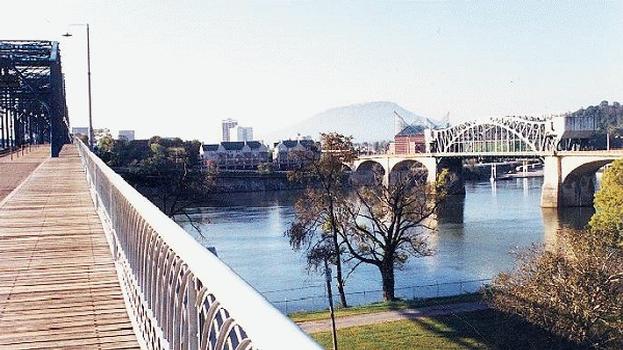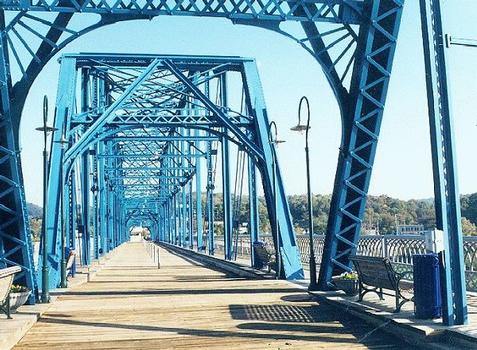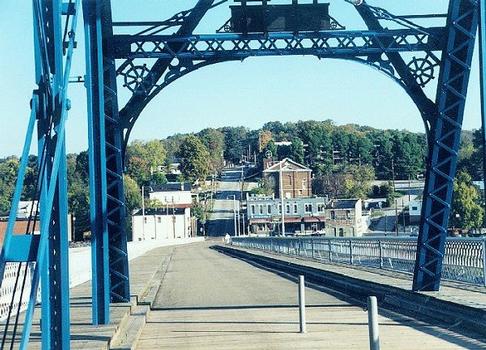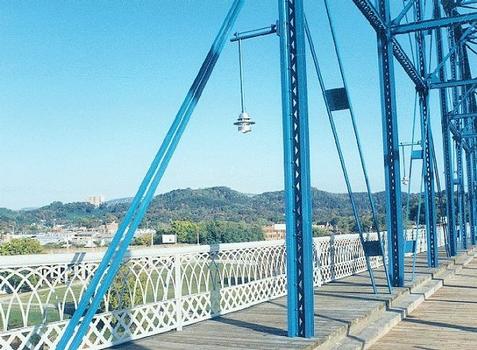General Information
| Completion: | 1891 |
|---|---|
| Status: | in use |
Project Type
| Structure: |
Through truss bridge |
|---|---|
| Material: |
Steel bridge |
| Structure: |
Camelback truss bridge |
| Material: |
Structurae Plus/Pro - Subscribe Now! |
| Function / usage: |
original use: Road bridge current use: Bicycle and pedestrian bridge |
Awards and Distinctions
| 1990 |
for registered users |
|---|
Location
| Location: |
Chattanooga, Hamilton County, Tennessee, USA |
|---|---|
| Crosses: |
|
| Coordinates: | 35° 3' 42.68" N 85° 18' 24.38" W |
Technical Information
Dimensions
| total length | 724 m | |
| clearance | ca. 30 m | |
| number of spans | 6 |
Materials
| piers |
masonry
|
|---|---|
| truss |
steel
|
Chronology
| 1978 | Removed from highway service |
|---|---|
| 1993 | Restored as a pedestrian-only span. The restoration was funded in part through a USDOT demonstration grant to US cities. |
Excerpt from Wikipedia
Built in 1890, the 2,376 feet (724 m) Walnut Street Bridge was the first to connect Chattanooga, Tennessee's downtown with North Chattanooga. The bridge's main spans are pin-connected Pennsylvania through truss spans. The top chord of these truss spans are configured in five sections, making the spans similar to the Camelback truss design. The bridge is historically significant as an extremely long and old example of its type; according to the Historic American Engineering Record: "The bridge was apparently the first non-military highway bridge across the Tennessee River."
History
According to a plaque on the bridge, Edwin Thacher was the chief engineer for the bridge. The bridge's superstructure was assembled by the Smith Bridge Company of Toledo, Ohio, which was a prolific late 19th-century bridge builder. The bridge's substructure was constructed by Neeley, Smith, and Company of Chattanooga. Most of the parts for the bridge were manufactured by Manly Jail Works of Dalton, Georgia and then shipped to the site by rail.
A former Union officer from Ann Arbor, Michigan, William Andrew Slayton (1854–1935) was the stone contractor. Slayton lived in a stone house at 533 Barton Avenue, the house known for years by later inhabitants as the location of the "Little Art Shop." It is not known if he built this house, but similarly to Washington Roebling and the Brooklyn Bridge, he could overlook the project from his window. Many of the low stone walls in North Chattanooga are made up of the remnants of stones deemed too small for use in the piers. Subdivision plats in Chattanooga suggest that Slayton developed some areas to facilitate the hauling of materials from quarries in northeastern Alabama, and Slayton Street and Slayton Avenue are found near the current public library location on Broad Street. Slayton's obituary fails to note that there is no stone on his grave at Chattanooga Memorial near Red Bank, Tennessee.
The "county bridge", as the Walnut Street Bridge was once known, connected the predominantly white city on the south side of the Tennessee River with the large black work force on the north side ("North Shore") in Hill City, a town that was annexed by Chattanooga in 1912.
Two black men were lynched on the bridge: Alfred Blount on February 14, 1893, was hanged from the first span for allegedly attacking a white woman; Ed Johnson on March 19, 1906, was hanged from the second span, also for allegedly attacking a white woman. Johnson's lynching initiated a court case (United States v. Shipp) before the Supreme Court that is notable for being the only criminal trial in its history.
Reconstruction
The bridge was closed to motor vehicles in 1978 and sat in disuse and disrepair for nearly a decade. Repairs and structural modifications have been made to turn the bridge into what is now a pedestrian walkway. The Walnut Street Bridge was added to the National Register of Historic Places on February 23, 1990. The 2,376 foot (720 m) pedestrian bridge sits near the heart of a massive and recently completed urban renewal project.
From December 2009 to May 2010, the bridge's deteriorating asphalt surface was replaced with wood planking. The City Council awarded a $1.3 million contract to Tower Construction for the bridge repair work.
The Walnut Street Bridge fund was started by Chattanooga Venture, a community group, to receive funds to be used by the city toward restoration of the bridge. Once the campaign was finished, the remaining funds were used for additional improvements to the bridge. These funds led to the replacement of original plaques which had been damaged, vandalized, or stolen. The original plaques have been renamed to The Parks Foundation, an organization committed to enhancements, improvements and programming to extend the utilization of all our parks and public space to the greatest number of people. The foundation is offering new plaques to donors that strive for the same mission.
Text imported from Wikipedia article "Walnut Street Bridge (Chattanooga)" and modified on July 29, 2020 according to the CC-BY-SA 4.0 International license.
Participants
- Edwin Thacher (designer)
- Andrew Smith (consulting engineer)
- Garnet Chapin (consulting engineer)
Relevant Web Sites
Relevant Publications
- (1984): Great American Bridges and Dams. A National Trust Guide. John Wiley & Sons, New York (USA), pp. 185-186.
- About this
data sheet - Structure-ID
20001380 - Published on:
25/03/2001 - Last updated on:
05/02/2016










